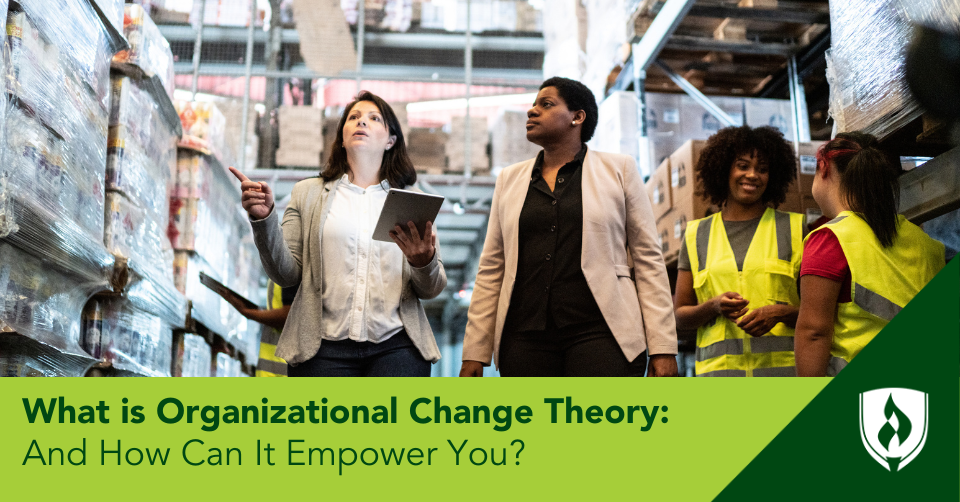
The only constant in life is change. Ever since Heraclitus said it, we’ve recognized this as pretty true. Yet, humans resist change like Peter Pan resists growing up. We feel comfortable with what we know and how we’ve been doing things.
In the ever-evolving landscape of business, organizations and corporations, that “things are fine” attitude can be the difference between thriving and going under. Change is not merely an option but an imperative.
Still, it’s easier said than done. How do companies navigate the complex and often treacherous terrain of change?
Understanding organizational change theory can help you see what makes transformations successful. And it doesn’t just work on a large-organizational level. It can have some pretty interesting implications for your personal career as well. Whether you're already a business pro or a student on your way, you need to know the true potential of change before you can experience it, or better yet, leverage it to your advantage!
What is organizational change theory?
Organizational change theory is also known as stage theory, change management or organizational change management (OCM), and it is a multidisciplinary field of study that seeks to understand and explain how organizations implement change and undergo a transformational process.
It encompasses a range of theories and frameworks to explain the dynamics involved in managing and implementing change within organizations, including the impact those changes have on employees, customers, stakeholders and others.
The ultimate goal of organizational change management is to find the best strategies for leading successful transformations within an organization. It's all about navigating the twists and turns of shifting structures, systems, cultures and behaviors to adapt to different pressures and seize exciting new opportunities.
At its core, organizational change management explores change—how drastic it can get and what it needs to really take hold. Since so much of this is about influencing and understanding people—organizational change management often rises from advanced Human Resources training.
This theory serves as a valuable guide for leaders, managers and business professionals who need to foster resilience and promote sustainable growth in today's dynamic business landscape.
7 big reasons why organizational change theory matters in business
Organizational change theory helps companies adapt and excel. You can see why people would be interested in it. Here are some big things organizational change theory can help with.
1. Adapting to a changing environment/market
In today's fast-paced business world, things change fast, and companies need to be ready – they need to be flexible, responsive and intentional. Organizational change management provides valuable guidance on how businesses can adjust to shifting market conditions, technological advancements, competition and customer expectations.
2. Gaining a competitive edge
Change theory helps businesses identify opportunities for innovation, improvement and growth. By embracing change and continuously enhancing processes, products and services, companies can stay ahead of their competitors.
3. Dealing with complexity
As businesses grow, they become more complex, and so does their organizational structure. The change management theory offers practical frameworks, models and approaches to help businesses navigate the complexity effectively. It assists leaders and managers in streamlining operations, optimizing structures and promoting effective communication and collaboration.
4. Improving organizational performance
Organizational change management focuses on enhancing overall effectiveness and performance. It provides tools and strategies to streamline workflows, eliminate inefficiencies, engage employees (promote employee input) and align individual and organizational goals. By implementing change initiatives successfully, businesses can achieve higher levels of performance and success.
5. Meeting stakeholder expectations
Businesses have various stakeholders, including employees, customers, shareholders, suppliers and the community. These stakeholders expect companies to adapt to their changing needs and preferences. Organizational change management theory helps businesses understand and meet these expectations, fostering positive relationships and alignment.
6. Overcoming challenges
Change initiatives often face resistance and challenges within organizations. Organizational theory equips businesses with strategies to manage employee resistance, address concerns and overcome obstacles.
By understanding the dynamics of change and utilizing appropriate change management approaches, businesses can mitigate risks and increase the likelihood of success.
7. Nurturing innovation and growth
Change theory encourages organizations to embrace innovation and explore new opportunities. It promotes a culture of continuous improvement, creativity and learning, allowing businesses to adapt to emerging trends, technologies and customer demands.
By fostering innovation and growth, companies can remain relevant and gain competitive advantages.
How change theory can affect your personal and professional life
Change management theory benefits individuals personally and professionally. It can help you navigate personal transitions, manage emotions and embrace change with resilience. By developing problem-solving skills and a strategic mindset, you can tackle personal challenges effectively.
This theory promotes continuous personal growth, encourages continuous learning and could also open doors to new opportunities. Professionally, it equips you with leadership, problem-solving and communication skills to successfully lead change initiatives, navigate workplace transformations and foster collaboration.
Here are several ways organizational change management can enhance your personal and professional skill set:
Professional growth and adaptability
Grasping change management theory helps individuals navigate workplace changes more effectively, like reorganizations or process adjustments. They can adapt to new roles, acquire new skills and actively contribute to change initiatives. This enhances their professional growth and makes them more valuable in the job market.
Leadership and management skills
Organizational theory provides a solid foundation for aspiring leaders and managers. It equips them with practical frameworks and strategies to lead change, communicate with stakeholders, and address resistance. Understanding change dynamics helps individuals become better leaders, inspiring and motivating others during times of transformation.
Problem-solving and decision-making
Organizational theory fosters critical thinking and problem-solving skills. Individuals who understand it can analyze organizational challenges, identify improvement opportunities, and propose effective solutions. They become skilled at evaluating risks, considering different perspectives, and making informed decisions. These skills are applicable to various personal and professional situations.
Resilience and adaptability
Change is a constant in both professional and personal life. Understanding organizational theory helps individuals embrace change, build resilience, and adapt to new circumstances. They develop the ability to navigate uncertainty, cope with challenges, and find personal growth opportunities amidst change.
Collaboration and communication
Change management theory emphasizes the importance of effective communication and collaboration. Individuals who grasp its concepts improve their ability to communicate change, engage stakeholders, and foster teamwork.
These skills enhance relationship-building, conflict resolution, and collaboration at work and in personal settings.
Personal growth and self-awareness
Understanding organizational theory promotes personal growth and self-awareness. Individuals gain insights into their own responses to change, enabling them to manage emotions and navigate personal transitions more effectively. They become more adaptable, open to learning, and view change as an opportunity for personal development.
How does organizational change get started?
All well and good, you might be thinking. Organizational change theory sounds useful. But where can a company even begin this process? In the realm of change management theory, drivers of change are what push organizations to transform and adapt.1
These drivers can come from all sorts of places, both inside and outside the organization, and they create the need for change. Let's take a look at some of the usual suspects:
- Technological advancements
- Market forces
- Changes in regulatory or legal requirements
- Economic factors
- Internal pressures, size changes or acquisitions
- External stakeholder expectations
These drivers of change vary in importance depending on the industry, the specific organization and what's happening in the world. Understanding these drivers helps organizations stay on their toes, ready to recognize when a moment for change has arrived.
Types of organizational change
Modifying organizational structures can bring a fresh perspective into focus. Organizational change can take on different forms, each with its own unique characteristics and goals.2 Here are some common types of organizational changes:
1. Strategic change
This type of change focuses on the big picture, involving shifts in the organization's overall direction and long-term goals. It happens when the organization adapts its mission, vision, strategy or core processes to respond to external changes or explore new opportunities.
2. Structural change
This involves implementing changes to how the organization is organized (strategy structure systems). It can include things like changing the hierarchy, reporting relationships, departments or how work is divided among teams. The aim is to improve efficiency, communication and coordination within the organization.
3. Cultural change
Cultural change revolves around transforming the values, beliefs, norms and behaviors that shape the company culture. The goal is to create a new culture that aligns with the desired vision, encouraging collaboration, innovation, adaptability or customer focus.
4. Process change
Process change improved the organization's operational processes and workflows. It aims to make things more efficient, reduce costs, eliminate unnecessary steps or enhance quality by adopting new technologies, streamlining procedures or following best practices.
5. Technological change
This type of change introduces or integrates new technologies within the organization. This could mean implementing new software systems, automation, digital tools or advanced machinery (ex: utilizing AI)to boost productivity, drive innovation or support day-to-day operations.
6. Personnel change
Personnel change emphasizes developing and enhancing the skills, knowledge and capabilities of individuals within the organization. It may involve training programs, talent development initiatives, performance management systems or planning for future leaders to foster personal and organizational growth.
7. Incremental change
Incremental change happens gradually over time, short term wins here, short term wins there. This involves small improvements or refinements to existing processes, products or services. The goal is to continuously enhance efficiency, quality or customer satisfaction through ongoing adjustments.
8. Transformational change
Transformational change is a significant and radical shift that fundamentally transforms the organization. These are large scale changes. It often requires a comprehensive and holistic approach to drive substantial organizational development to create a new status quo.
Change management approaches to consider
Change management approaches refer to the different ways to tackle and handle change within an organization, and they provide frameworks and strategies on how best to handle it.
It is important to choose the approach that fits the unique characteristics of your organization, while also considering the needs and preferences of the people involved. Here are some of the popular change management models and change management frameworks:
Lewin's change management model
This model, created by Kurt Lewin, breaks change down into three stages: unfreezing, moving and refreezing. It's all about getting people ready for change, making the change happen and then making sure the new way of doing things sticks.
Kotter's 8-step change management model
This model by John Kotter provides a step-by-step plan for leading change. It starts with creating a sense of urgency, building a team of change champions, setting a vision and strategy, communicating the change, empowering employees, celebrating early wins, consolidating progress and embedding the change into the organization's culture.
ADKAR® model
The ADKAR model focuses on individual change. It looks at five elements:
- Awareness of the need for change
- Desire to support the change
- Knowledge about how to change
- Ability to actually make the change
- Reinforcement to make the change stick.
Agile change management
This approach is a change management framework borrowed from Agile project management methodologies. It's all about being flexible and adaptable, taking small steps, getting feedback along the way, working collaboratively and constantly learning as we navigate change.
Appreciative inquiry
Appreciative inquiry focuses on what's already working well, getting people involved in creating a shared vision of the future and designing actions to make that vision a reality.
Lean Six Sigma®
Six Sigma, originally a quality management approach, is also used for change management. It relies on data, process improvement and measurement to make change effective and efficient.
Proactive change management
This approach is all about staying one step ahead. It involves keeping an eye on the external environment, looking for signs of change or new opportunities and taking strategic action before change hits.
Participatory change management
The participatory approach is about involving everyone who will be affected by the change. It emphasizes collaboration, communication and making decisions together, so that everyone has a say and feels invested in the change.
How does organizational change theory address resistance to change?
Resistance to change, as we know, is human nature.1 Fueled by fear of the unknown, people resist change for many reasons, but generally because they fear losing some sense of control, like job security or disruptions to routines and budgets.
By applying organizational theory, business leaders can uncover the map to navigate resistance. They learn to spot the hidden sources that make folks hesitant, involve stakeholders early in the change process and communicate the benefits and reasons for the proposed changes.
Additionally, the theory emphasizes the importance of involving employees in the change process, empowering them to contribute their ideas and concerns.
By addressing resistance proactively and involving individuals in the change journey, organizations can mitigate resistance and foster a sense of ownership and commitment to the desired changes.
Also, change management theory highlights the significance of providing support and resources to people during the change process.
Evaluation and measurement in organizational change theory
Evaluating and measuring results is a key part of change management theory. It helps you see how well your change efforts are working and what impact they're having.
So, how do you go about it? Well, first things first, you need to set clear objectives and goals for your change initiative. These act as your target and help you figure out what you're aiming for.
Once you know what you're aiming for, you can start to collect data. This can involve things like surveys, interviews or even just keeping an eye on how things are going.
After you've collected some data, it's time to analyze it. This means looking at the results and comparing them to your objectives. Did you hit the mark? Did you make progress? It's all about seeing how well your change initiative is doing and figuring out what you can learn from it.
And hey, don't forget to use those insights to make improvements for the future. Change is all about growing and getting better, so make the most of what you've learned and keep on evolving.
Where can change management theory be implemented?
The following are just a few examples, but in reality, change management theory can be implemented in any setting where organizational change is necessary.
Business organizations
Whether it's a small startup or a big corporation, change management theory comes in handy when businesses need to make big moves. It helps them tackle mergers, reorganizations, process improvements, new technologies and even shifts in company culture. By using change management principles, businesses can navigate these changes like pros.
Nonprofit organizations
Yep, even nonprofits can benefit from change management theory. When they want to revamp their strategies, rebrand or change their programs, they can turn to change management to help them do it right. It ensures they can adapt to new challenges, stay relevant and achieve their noble missions.
Government and public sector
Change is not just for businesses and nonprofits – even government organizations need to keep up with the times. When they want to make organizational reforms, introduce new policies or launch shiny new initiatives, change management theory is their go-to guide. It helps them smoothly transition, involve all the important peeps and make those changes stick.
Healthcare and medical institutions
Doctors and hospitals also need a dose of change management from time to time. When they're adopting new technologies, improving patient care or changing up their procedures, they can turn to change management theory. It helps healthcare systems navigate those tricky transitions and ensure that patients get the best care possible.
Educational institutions
Even schools and colleges can benefit from change management theory. When they want to revamp their curriculum, embrace new teaching methods or improve their administrative processes, change management theory is there to help. It makes sure everyone, from teachers to students, can handle those changes like pros.
Is organizational change management in your future?
Bottom line, whether you're a seasoned business student or just starting your journey, truly knowing these theories will give you a competitive edge in the cut-throat, ever-evolving business world.
So, embrace the power of change management.
Delve into the intricacies of this theory and equip yourself with the knowledge and skills to navigate complex changes in your personal and professional life.
You could lead successful transformations, drive innovation and empower yourself and your employees. You could gain a valuable toolkit to address challenges, anticipate needs and future trends and contribute to the growth and success of your business.
Do you like how this sounds? Then check out our next article What Is Organizational Leadership? HR's Other Half.
Lean Six Sigma® Is a registered trademark of Lean Six Sigma DBA Lean Six Sigma
ADKAR® is a registered trademark of ADKAR Prosci, Inc.
1McQuillan, Susan. Why do Humans Resist Change? (2019) Psychology Today https://www.psychologytoday.com/us/blog/cravings/201910/why-do-humans-resist-change




